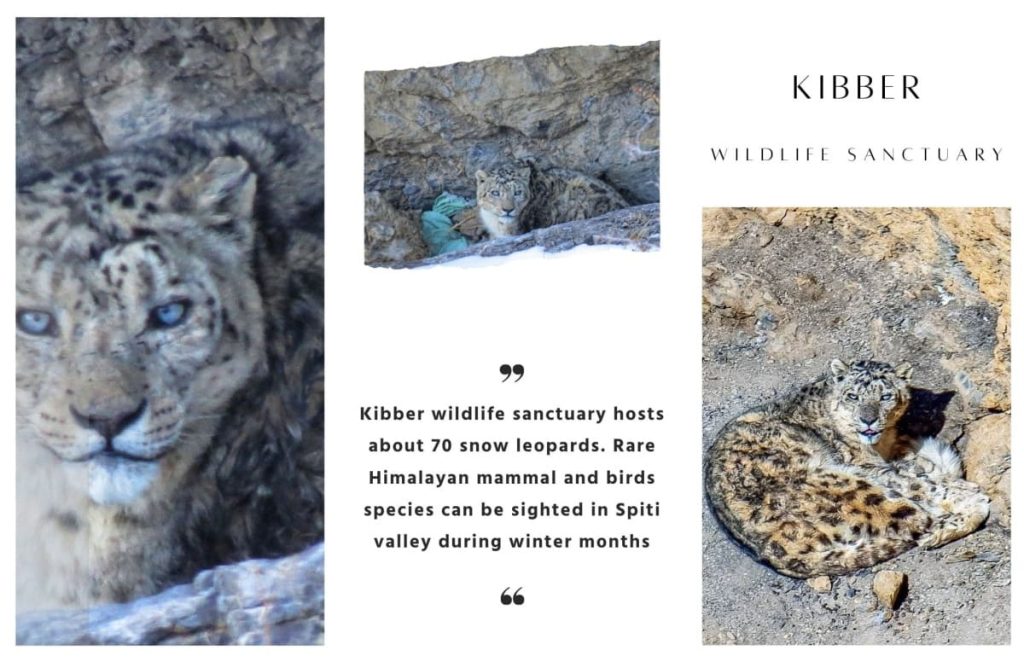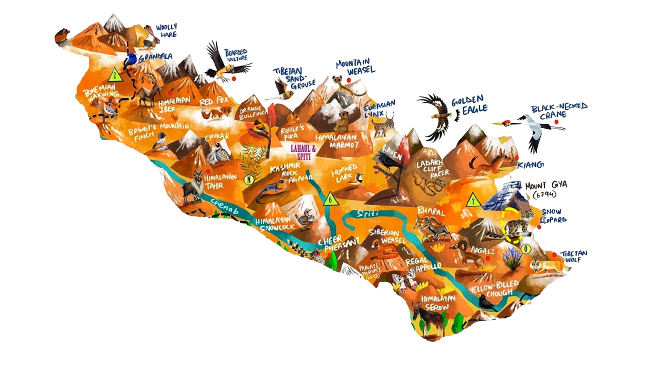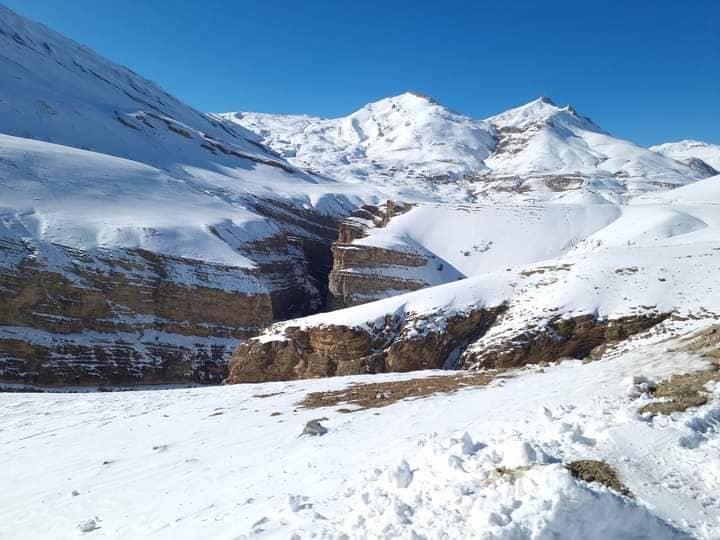If you’re fascinated by the most elusive cat, the king of camouflage, the apex predator of the Trans-Himalayas – Snow Leopard, this is the expedition you must go on.
What is a snow leopard expedition?
Snow Leopard Expedition is a wildlife sighting and photography tour that focuses on tracking and spotting snow leopards in Spiti Valley. It is a 9-day tour that starts from Chandigarh.


On this tour, four days are reserved for hiking, stalking, and spotting snow leopards in Kibber Wildlife Sanctuary.
Tracking Shen—Snow Leopard of Spiti, Himachal
Shen/Shan means snow leopard in Bhoti – a language spoken by the people of Spiti valley.
Kibber Wildlife Sanctuary is the prime habitat area for sighting and photographing snow leopards—the apex predator in the trans-Himalayas—in Himachal Pradesh.

It hosts one of the highest-density snow leopard populations in India. Despite the high population density, tracking and spotting, the snow leopard is still a matter of chance. A host of factors like time, spotting location and snowfall conditions affect your chances.
Dawn and dusk are the best times to spot the snow leopards. To find the prime places, one just has to find places where there is an abundance of snow leopard prey, which includes:
- Argali,
- Blue Sheep
- Ibexes,
- Himalyan Tahr
- Markhor
- Tibetan gazelle
- Woolly hares
- Calves of the Yaks.
Itinerary for photo expedition
Day 1: Chandigarh–Narkanda (altitude, 2700 m): Distance covered 175 km. Drive (on NH5) duration: 6 hours (Overnight stay at HPTDC hotel).
Day 2: Narkanda–Ralli, Kinnaur (altitude 2100 m). Distance covered 144 km. Drive time on NH5: 5-6 hours (Stay at Homestay).
Day 3: Ralli–Kibber Village (altitude, 4270 m): Drive time on NH5 and NH505: 7–8 hours. Overnight stay at a Homestay.
Day 4,5,6, and 7: Hiking and following the elusive snow leopard around Kibber Wildlife Sanctuary. Reach early for spotting places like Rong Nala in Kibber Wildlife Sanctuary. Snow leopard tracking guides and porters will lead you to the spot. There would not be any specific routine for these 4 days reserved for spotting snow leopards, as we need to move to the spotting places as soon as we hear about the sightings from our spotting guides.
Day 8: Kibber–Rampur Bushahr: 10 hours drive time, covering about 320 km. Stay at Nau Nabh Heritage hotel.
Day 9: Rampur Bushahr–Chandigarh Airport/ISBT
Expedition Highlights:
1. Highly experienced team of trackers, guides, and wildlife photography tour organizers.
2. All staff members are local.
3. All-inclusive trip.
5. Premium Accommodation at Hotel and Homestays with heating facilities.
6. Foldable Camping Chairs for seating while waiting for snow leopard sighting.
7. Opportunity to photograph other Himalayan wildlife like Ibex, Blue sheep, and Red foxes.
How to spot and photograph snow leopards in Himachal Pradesh?
Here are some tips to increase your chances of sighting snow leopards in Himachal Pradesh.
- Visit places that have the most frequent sightings in the past: Kibber Wildlife Sanctuary and high altitude regions of Lahaul valley of Lahaul-Spiti district of Himachal Pradesh have highest-density population in India. Track snow leopards in such places to maximize your chances.
- Hire local spotter/guides: They have the best knowledge of the terrain, the weather, best time and the spotting locations in their area. They can also help you with sanctuary/national park permits, logistics, and safety.
- Plan your trip after a snowfall: Snow leopards are easier to spot against a snowy backgrounds, as their grey fur stands out more. Snow also makes their tracks more visible, which can help you track them down.
- Be patient and persistent: Snow leopards are hailed as the master of camouflaging. They are rare and shy animals that can go unnoticed for days or weeks. You need to be prepared to spend long hours in the cold, waiting and watching for any sign of movement.
- Follow their prey: Snow leopards feed on mountain ungulates, such as ibexes and blue sheep. If you find these animals, you have a higher chance of finding a snow leopard nearby. Look for rocky outcrops, cliffs, and ledges where snow leopards like to ambush their prey.
- Study their behavior: Snow leopards have unique and fascinating habits that can help you understand and anticipate their actions. You can learn more about them from online resources, such as the Snow Leopard Trust and National Geographic, books, such as The Snow Leopard by Peter Matthiessen and Snow Leopard: Stories from the Roof of the World by Don Hunter, or talk to experts who have photographed snow leopards in the wild.
- Use the right equipment: Snow leopards are usually active at dawn and dusk, when the light is low and the colors are muted. You need a camera with a large aperture lens, a high ISO setting, and a fast shutter speed to capture sharp and clear images. You also need a sturdy tripod (Leofoto offers a great range of tripods for wildlife photography) to stabilize your camera and reduce camera shake.
- Capture the action: Snow leopards are agile and powerful hunters that can leap up to six times their body length. Shooting a snow leopard chasing an Ibex is a dream of every photographer. To photograph these spectacular moments, you need to use a continuous shooting mode and a fast shutter speed. You also need to be ready and alert, as these events can happen in a matter of seconds.
- Visit during the mating season: The best time to see and photograph snow leopards is from January to early March, when they are more active. This is also the time when they mate and form pairs. You can witness and capture the intimate and playful interactions of these elusive animals.
Inclusions
- Opportunity to witness the majesty of the Shen and photographing them in the wild. We have sighted snow leopards on all expeditions we have organized in the last six years.
- 2 Nights hotel accommodation (HPTDC Narkanda and Nau Nabh Heritage hotel, Rampur).
- 6 Nights homestay accommodation with wood burning Tandoor/ Bukhari heaters and all meals.
- Spotters / Scanners, Guide, porters for carrying camera gear.
- Walkie-talkie radios
- Monastery fees, wildlife permit fees, and Kibber village Panchayat fee.
- Hot water, tea, and snacks in homestay and at sighting spot.
- Walking pole.
- Foldable stools at spotting site.
- 4WD car for all itinerary days.
Essentials to carry along
- Two pairs of thermal base layer
- Good quality thick wool socks (2-3 pairs)
- High ankle trekking boots (Similar to Decathlon FORCLAZ 100 hiking shoes)
- Sweater and fleece for mid-layer
- Heavy down jacket for outer layer (Similar to Decathlon MT500)
- 100–400 mm zoom lenses or super telephoto (500 mm / 600 mm focal length) lenses
- Phone and camera batter chargers
- Batter backups and power banks
- Memory cards
- Good quality gloves
- Backpack (70-90 liter) for multi-days Hikes.
- A pair of trek gaiters – To prevent snow/moisture seeping inside the boot.
- Trekking Pole
- Wind-proof fleece pants / trousers – (at least 3 Trek Pants), no Jeans. Synthetic, Quick Dry fabric-based Trek Pants are ideal.
- Balaclava
- Sunglasses – They are a must for a snow hike. Carry UV rated ones.
- Water bottles – Avoid plastic drinking bottles.
- Toiletries (Sunscreen – SPF 60+, moisturizer, light towel, lip balm/chapstick, small soap, toilet paper, wet tissue)
- Headlamp/ LED Torch
- Energy bars/dry fruits. Essential for surviving the harsh winters of Kinnaur & Spiti valley.
- First-aid kit
Cancellation policy
- Full refund for all cancellations before 30 days of departure date
- 50% refund for all cancellations between 10 and 30 days before the departure date.
- 25% refund for all cancellations made 10 days before the departure date.
Key terms of expedition
- Extreme climate events and natural disasters are common in this north-eastern part of Himachal Pradesh. In case there occurs such an event, the expedition will be canceled, and we won’t be able to offer you any refund.
- You need to be in good health before starting this expedition. You’ll also need to provide proof of good health and fitness certificate on day 1 of the itinerary.
- Though we have spotted snow leopards on all previous expeditions, sighting them and capturing them in a perfect frame is still a matter of chance. Probability of sighting them gets increased whenever there is large snow precipitation. In case of such events, we may take liberty in rescheduling fixed departure dates and itinerary plan accordingly.

